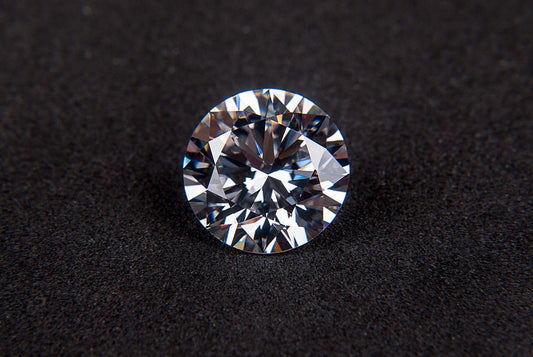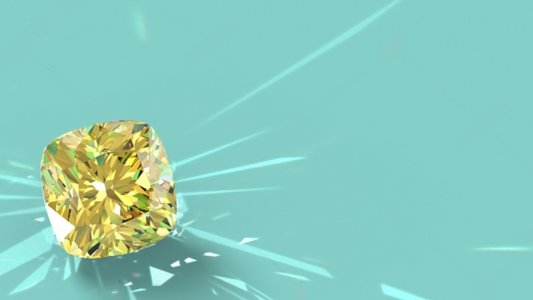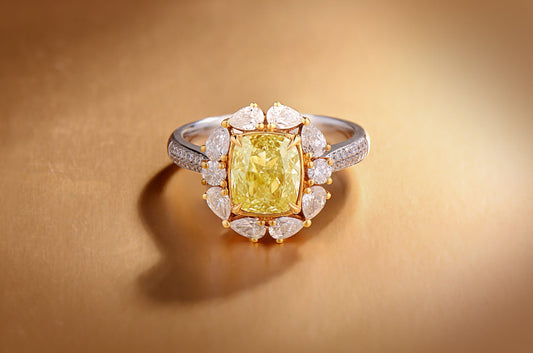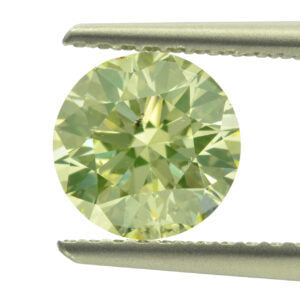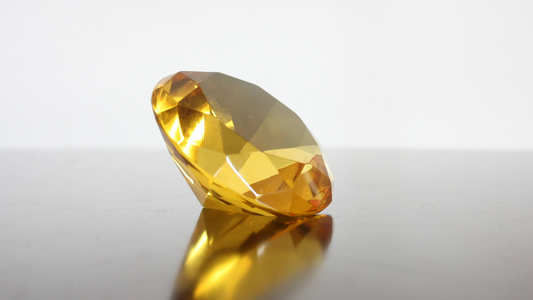
With celebrities wearing yellow diamonds at various red carpets events and just now at the Cannes film festival, the trend of yellow diamonds is "booming". You can also see more and more of them at the latest auctions and even last week to set world record for the priciest yellow diamond per carat ever!
Yellow diamonds are also getting the attention because many wearers begin to notice that fancy yellow diamonds reflect the most charming light which is believed to highlight the lovely features of its wearer. But, wait! Before you buy your yellow diamond, it will be helpful to know the differences between fancy light, fancy, fancy intense and vivid yellow diamonds.
What makes diamonds yellow?
It takes billions of carbon atoms to bond just to make a one-carat colorless diamond. But, if there is a slightest quirk- the diamond will be coloured. The smallest amount of nitrogen can turn a ‘colourless’ diamond into a yellow diamond.
So, how did the yellow diamond get its natural yellow color? The yellow color was created by the natural infusion of the trace elements of nitrogen during the formation of the diamond.
What affects the color intensity?
The color is affected by the nature of impurities and their effects on diamond’s light absorption. Type IaB diamonds with large even-numbered group of nitrogen atoms show a yellow to brown tint.
If unpaired nitrogen atoms are distributed throughout the crystal the diamond will have an intense yellow or occasionally, brown tint (Type Ib) color. A good example of this is the rare ‘canary’ diamonds.
Explanation:
Diamonds: 2 main types and subtypes
Type I diamonds: The main impurity is the “Nitrogen atoms” which is present at 0.1% concentration.
Subtypes:
Type IaA - If the nitrogen atoms present are in pairs. The color of the diamond is not affected.
Type IaB - The nitrogen atoms are in large even-numbered aggregates. The diamonds will have yellow to brown tint.
Type Ib - The unpaired or grouped nitrogen atoms are distributed all throughout the crystal in isolated sites. The color of the stone turns to intense yellow or rarely, brown tint. Example: Rare canary diamonds.
Type II diamonds: The nitrogen impurities are not measurable.
Type IIa - It ranges from color red, brown, or pink. It is a result of different structural anomalies that happened through plastic deformation during the crystal growth.
Type IIb: Example: Light blue diamond- It gets the color from scattered boron within the stone’s matrix.
There are also two factors that intensify the natural color of a diamond:
⦁ Natural radiation
⦁ Pressure
What about man-made techniques to intensity the color of yellow diamonds?
Laboratories can turn less colored diamond into yellow by doing any or all of these tricks:
1) Mimic the tricks of nature (“accidental” quirk of nitrogen)
2) Perform color treatments to enhance the diamond’s natural color
3) Neutralize the yellow color by applying a thin coat of blue into a slightly yellow diamond. This will create a visual perception of a higher color grade.
4) Irradiation to intensify the yellow color. It is the use of nuclear reactor or linear accelerator and sometimes heating to produce different fancy colored stones.
*** It is important to note that the criteria buyers use in purchasing colored diamonds do not apply to colorless diamonds.
What does that mean?
White diamonds are measured according to the 4 C's. The GIA is the leading gemological lab and we shall analyze diamonds grading according to their standards.
White diamonds color grading is measured from D – the top color, which means that the diamond has no trace of any color….Meaning it is white. The other end of the "Normal" color range is Z, which means that the diamond has the most amount of color in the "Normal" color range. Beyond that, when a diamond contain more color, it "skips" to the next color range of fancy colors.
In the normal color range "D color" besides being the whitest, is the ‘rarest’ among white diamonds and it is also more expensive.
With fancy color grading, it goes the opposite way- meaning, "Vivid color grade" that contains the most color is the ‘rarest’ and the most expensive of the various color intensity grades.
*** There are two more grades that contain much color concentration: Deep and Dark. These two grades are not as clear in terms of value, since they appear in various forms in terms of looks. In terms of value- they range between Fancy and Fancy Vivid, depending on the specific color of each stone.***
SHAPE:
How the shape of diamond affect both color and price of yellow diamonds?
1. Round - The round shape is cut in order to maximize fire and brilliance. It aims to reflect as much as possible light back up through the diamond’s table.
Round shaped yellow diamonds are very rare due to the attribution of this shape. However, some vivid, deep and dark yellow diamonds are cut into rounds (since the color concentration so strong), so it does not harm the color strength.
2. Oval - Compared to rounds, it provides a larger surface area for the same carat weight.
With regards to yellow diamonds, the shape has a great tendency to concentrate color very well, and it actually upgrades both its price and looks.
3. Emerald-shaped diamonds reveal the elegance and classic beauty better than any other shape. Emeralds are not so common when cutting fancy color diamonds in general since they do not "hold" color as well. The Emerald shape gives the diamond a crystal look which is best for top color white diamonds: D- G colors mostly.
4. Pear shape - Quite popular cut for yellow diamond and when cut well achieves a premium price in comparison to the rest of the cuts, since it concentrates color very well.
5. Radiant cut - Radiant is a very popular shape when cutting fancy color diamonds in general. The shape tends to concentrate color very well.
6. Cushion cut - It is also a popular cut for the same reasons as the radiant shape.
After reviewing the differences between white and yellow diamonds let’s figure out the differences between the 4 major intensities.
What determines the intensity? The intensity of the diamond is determined by the strength of a color.
There are three parameters that build the color grading in Fancy colored diamonds. These include the diamonds:
1. Main color
2. Tone
3. Saturation
Both tone and saturation define the color intensity of Fancy yellow diamonds. The intensity level varies from a very soft shade up to a very strong one. In general, the stronger the diamond's shade, the higher will be its value.
There are nine intensity levels which the GIA developed to categorize the diamond’s intensity levels. These nine grades in the intensity scale include:
1) Faint
2) Very Light
3) Light
4) Fancy Light
5) Fancy
6) Fancy Intense
7) Fancy Vivid
8) Fancy Deep
9) Fancy Dark
How color intensity is determined by the GIA:
GIA bases the intensity grading of the diamond based upon the combination of three factors:
1. Hue-overall body color of the diamond (example: yellow)
2. Tone-lightness or darkness of diamonds
3. Saturation-intensity of the color
Tone
Tone aims to measure the lightness or darkness of the diamond’s color or hue. It often refers to the intensity of the color of the diamond. Tone is measured in a 7 levels scale: Very Light; Light; Medium Light; Medium; Medium Dark; Dark; Very Dark.
Saturation:
Saturation is the second factor that measures the intensity of the color combined with the tone. There are 6 levels used by GIA to grade a diamond’ saturation: Fancy Light, Fancy, Fancy Intense, Fancy Dark, Fancy Deep, and Fancy Vivid.
As to pricing
Among the four shades above, the fancy vivid grade has the highest price per carat. The fancy light yellow will fetch the lowest price in general.
Is color all that matters with yellow diamonds pricing?
While color is the primary consideration, it is still the interaction between the four determining factors that will establish the value of a diamond.
While the cutter can decide on the cut and the shape of the diamond, it is nature itself which is responsible for the first three C’s-clarity, color and carat. The interaction between these four, assist to determine the correct price.
What really matters…?
Consumers have their own personal choices when it comes to buying fancy colored diamonds.
Many buyers buy for investment while others also intend to use it for personal purposes. Since much is depend on the buyer’s personal preference and the reasons for the purchase, there is no conclusive determining factor of the diamond’s pricing. Take for instance, the ‘Graff Vivid Yellow’ diamond which was sold at the latest Sotheby’s Magnificent Jewels Auction in Geneva. Though the bid started at $$13,187,302, the bid quickly went up and it was eventually sold at $16.3 million.
Sometimes, buyers overlook the clarity and size of the fancy yellow diamond all for its attractive color. At times, others may also prioritize the size and carat more than the color.
Many investors and individuals also purchase fancy color diamonds based on their “naked eyes” assessment of its clarity while others are after the diamond’s cut because it brings out the the most or a unique color.
In most cases, buyers opt for fancy color diamonds with good color and good cut in a medium clarity grading. While the 4 C’s in buying a fancy color diamond seems to be the ultimate guide, the truth is-it’s the individual’s personal preferences and style that really matter.
The GIA issues a diamond certificate which specifies the attributes of the diamonds if intensity and color is evenly or unevenly distributed based on the color distribution’s percentage. The diamond certificate also assures the buyer of the worth and authentication of the fancy yellow diamond.
FAQ on Yellow Diamonds Intensity
What determines the intensity of color in yellow diamonds?
The presence of nitrogen within the diamond gives rise to a yellowish hue. It's fascinating how the presence of more nitrogen atoms strengthens the yellow color of the diamond. So, you can see yellow diamonds ranging from really light yellow to these bold and intense yellow shades.
How is the intensity of yellow diamonds graded?
Yellow diamonds are graded using a scale from "Faint” to "Vivid” by the Gemological Institute Of America (GIA). They use nine intensity levels to categorize yellow diamonds: Faint, Very Light. Light, Fancy Intense, Fancy Vivid, Fancy Deep, and Fancy Dark. These shades are examined based on the overall strength and deepness of the yellow color.
What is the significance of intensity in yellow diamond pricing?
The value and price of yellow diamonds are determined a lot by how robust their color is. Diamonds with stronger colors, like Fancy Vivid and Fancy Intense are not ordinary and are worth more money. These diamonds show off a solid and attractive yellow color, making them visually appealing to collectors and investors.
Can intensity affect the visual appearance of a yellow diamond?
Yes, the visual impression of a yellow diamond is affected by its intensity. Diamonds with stronger passion demonstrate a more vibrant and distinct yellow hue. This aspect makes them more appealing and a popular option in jewelry, particularly in the pieces where color is an eminent feature.
Are there variations in hue within different intensity grades of yellow diamonds?
Yes, even within a given intensity grade (such as Fancy Intense), there can still be differences in the exact shade of yellow. Some diamonds have more orange-yellow, while others could look more like a soft lemon-yellow. The specific hue, along with the intensity, adds to the overall attractiveness and uniqueness of the diamond.
